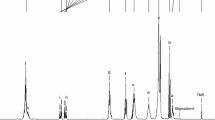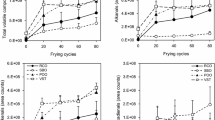Abstract
Cold pressed and hexane extracted moringa seed oils (CPMSO and HEMSO) were evaluated for their physico-chemical and stability characteristics. The iodine value, saponification value and unsaponifiable matter of CPMSO and HEMSO were found to be 67.8 and 68.5 g I2 / 100 g oil, 190.4 and 191.2 mg KOH / g oil and 0.59 and 0.65%, respectively. The total tocopherols of CPMSO and HEMSO were found to be 95.5 and 90.2 mg/Kg. The fatty acid composition of CPMSO and HEMSO showed oleic acid as the major fatty acid (78–79%). The oxidative, thermal and frying stabilities of the CPMSO were compared with commercial raw and refined groundnut oil (GNO and RGNO). The CPMSO was of adequate thermal stability and better oxidative stability as it showed 79% lesser peroxide formation than GNO. The frying stability of CPMSO was better as it showed lower increase in free fatty acid (28%), peroxide value (10 meq O2/Kg) and color (25%) than RGNO (48%, 22 meq O2/kg and 52%, respectively) after frying.

Similar content being viewed by others
References
Abdulkarim SM, Long K, Lai OM, Muhammad SKS, Ghazali HM (2005) Some physico-chemical properties of Moringa oleifera seed oil extracted using solvent and aqueous enzymatic methods. Food Chem 93:253–263
Abdulkarim SM, Long K, Lai OM, Muhammad SKS, Ghazali HM (2007) Frying quality and stability of high-oleic Moringa oleifera seed oil in comparison with other vegetable oils. Food Chem 105:1382–1389
Ayerza R (2011) Seed yield components, oil content, and fatty acid composition of two cultivars of moringa (Moringa oleifera Lam.) growing in the Arid Chaco of Argentina. Ind Crops Prod 33:389–394
Bhatnagar AS, Prasanthkumar PK, Hemavathy J, Gopalakrishna AG (2009) Fatty acid composition, oxidative stability and radical scavenging activity of vegetable oil blends with coconut oil. J Am Oil Chem Soc 86:991–999
Canning SP, Fazio PC, Fisher D, Gutman EL, Hsia CT, Kauffman SL, Kramer J, Lane M, Leinweber CM, Mcgee PA (1991) Methods of the American Society for Testing and Materials, ASTM D 445, ASTM D 1298, ASTM D 368, ASTM D 891, ASTM D 369. pp 168–173.
Choe E, Min DB (2007) Chemistry of deep-fat frying oils. J Food Sci 72(5):R77–86
Cunnif P (2000) Official methods of association of official analytical chemists. International Association of Official Analytical Chemists (AOAC). Vol. II, 17th Ed. (pp 1–37). Arlington VA USA.
da Silva JPV, Serra TM, Gossmann M, Wolf CR, Meneghetti MR, Meneghetti SMP (2010) Moringa oleifera oil: Studies of characterization and biodiesel production. Biomass Bioenergy 34:1527–1530
Farooq A, Syeda NZ, Umer R (2006) Characterization of Moringa oleifera seed oil from drought and irrigated regions of Punjab, Pakistan. Grasas Y Aceites 57(2):160–168
Firestone D (1997) Official methods and recommended practices of the American Oil Chemists Society, AOCS method no. ca 5a-40, AOCS method no. ca 6a-40, AOCS method no. cd 8–53, AOCS method no. cd 3c-91, AOCS method no. ce 1–62. 5th Ed. AOCS press, 1608, Broadmoore drive Champaign, Illinois-61826 USA.
Foidl N, Makkar HPS, Becker K (2001) The potential of Moringa oleifera for agricultural and industrial uses. Moringa review proceedings in Dar Es Salaam, Tanzania, Oct. 20th – Nov. 2nd 2001.
Graphpad instat demo-[dataset1.isd]. Graphpad Software Inc. 11452, EI Camino Real, #215, San Digeo, 92130 USA. www.graphpad.com (Accessed on Jan. 9, 2010).
Kibazohi O, Sangwan RS (2011) Vegetable oil production potential from Jatropha curcas, Croton megalocarpus, Aleurites moluccana, Moringa oleifera and Pachira glabra: assessment of renewable energy resources for bio-energy production in Africa. Biomass Bioenergy 35:1352–1356
Lalas S, Gortzi O, Tsaknis J (2006) Frying stability of Moringa stenopetala seed oil. Plant Foods Hum Nutr 61:93–102
Lalas S, Tsaknis J (2002) Characterization of Moringa oleifera seed oil variety Periyakulam-1. J Food Comp Ana 15(1):65–77
Latif S, Anwar F (2008) Quality assessment of Moringa concanensis seed oil extracted through solvent and aqueous-enzymatic techniques. Grasas Y Aceites 59:69–75
Manzoor M, Anwar F, Iqbal T, Bhanger MI (2007) Physico-chemical characterization of Moringa concanensis seeds and seed oil. J Amer Oil Chem Soc 84:413–419
Ogunsina BS, Radha C, GovardhanSingh RS (2010) Physicochemical and functional properties of full-fat and defatted Moringa oleifera kernel flour. Int J Food Sci Technol 45:2433–2439
Ogunsina BS, Radha C (2010) Comparative study of the functional and physico-chemical properties of debittered Moringa oleifera seeds and soybeans flours. Ife J Technol 19(1):85–92, Special Issue
Paquot C, Havtfenne A (1987) IUPAC method no. 2.301. Standard methods for analysis of oils, fats and derivatives. International Union of Pure and Applied Chemists, 7th Ed. Blackwell, Oxford, pp 174–182.
Rahman IMM, Barua S, Nazimuddin M, Begum ZA, Rahman MA, Hasegawa H (2009) Physicochemical properties of Moringa oleifera Lam. seed oil of the indigenous-cultivar of Bangladesh. J Food Lipids 16:540–553
Tsaknis J, Lalas S, Gergis V, Spiliotis V (1998) A total characterisation of Moringa oleifera Malawi seed oil. La Rivista Italiana Delle Sostanze Grasse 75:21–27
Tsaknis J, Lalas S, Gergis V, Dourtoglou V, Spilitois V (1999a) Characterization of Moringa oleifera seed oil (mbololo variety of Kenya). J Agric Food Chem 47:4495–4499
Tsaknis J, Spiliotis V, Lalas S, Gergis V, Dourtoglou V (1999b) Quality changes of Moringa oleifera, variety Mbololo of Kenya, seed oil during frying. Grasas Y Aceites 50:37–48
Tsaknis J, Lalas S (2002) Stability during frying of Moringa oleifera seed oil variety “Periyakulam 1”. J Food Comp and Anal 15:79–101
Acknowledgements
This research work was funded by the United Nations University and Central Food Technological Research Institute (CFTRI), Mysore, India. Authors acknowledge Dr V. Prakash, Director, CFTRI, for providing infrastructural facilities. Thanks are due to Dr A. G. Appu Rao, Head of Protein Chemistry and Technology and Dr B.R. Lokesh, Head of Lipid Science and Traditional Foods for their valuable suggestions.
Author information
Authors and Affiliations
Corresponding author
Rights and permissions
About this article
Cite this article
Ogunsina, B.S., Indira, T.N., Bhatnagar, A.S. et al. Quality characteristics and stability of Moringa oleifera seed oil of Indian origin. J Food Sci Technol 51, 503–510 (2014). https://doi.org/10.1007/s13197-011-0519-5
Revised:
Accepted:
Published:
Issue Date:
DOI: https://doi.org/10.1007/s13197-011-0519-5




